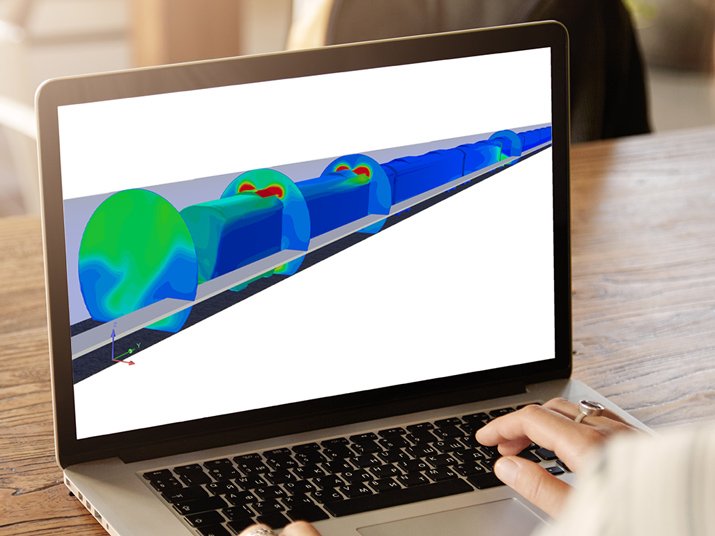In the construction industry, paying close attention to every last detail is of the utmost importance, especially when working on massive underground infrastructure projects.
Construction companies often tackle these complex endeavors, where every facet of design requires careful consideration because overlooking even minor details during underground infrastructure projects can lead to serious consequences and potential failures.
Addressing ventilation efficiency is vital for underground structures, as it directly impacts their safety, comfort, and functionality. It guarantees ideal air quality, temperature, and humidity levels, making it a key concern.
This is where computational fluid dynamics (CFD) modeling services have been a game-changer in this domain.
By leveraging CFD simulation for underground ventilation, these services provide invaluable insights into airflow patterns, heat distribution, and ventilation efficiency, ultimately enhancing the safety, functionality, and overall performance of underground structures.
This article will explore the transformative role of CFD modeling services, specifically focusing on enhancing ventilation efficiency in underground infrastructure projects.
CFD modeling services play a vital role in analyzing and optimizing ventilation design in underground infrastructure. These services encompass various applications, including:
CFD simulation for underground ventilation allows for evaluating airflow patterns and velocity distribution within tunnels. This helps identify areas of low air circulation, enabling engineers to implement corrective measures.

Understanding the distribution of heat and its dissipation within a structure is critical for maintaining comfortable temperatures. CFD modeling assists in analyzing heat transfer mechanisms, predicting temperature distribution, and optimizing cooling strategies.
Underground spaces often experience high pedestrian traffic, increasing heat generation. CFD modeling allows engineers to analyze the impact of human activity on temperature and ventilation, helping them design systems capable of managing these effects.

CFD modeling services have a transformative impact on underground infrastructure, revolutionizing ventilation system design, analysis, and optimization. Here’s how CFD modeling services transform underground infrastructure:
CFD modeling services utilize advanced numerical techniques and algorithms to accurately simulate and visualize the behavior of fluids and gases within complex architectural systems. This enables engineers and designers to comprehensively understand airflow patterns, temperature distribution, and air quality within underground structures.

CFD simulation for underground ventilation enables the assessment and optimization of ventilation system design. By considering factors such as airflow rates, and air circulation, CFD modeling services help identify potential issues, improve air distribution, and optimize the placement and performance of ventilation equipment.
CFD modeling services facilitate the identification of areas with poor airflow or stagnation within underground structures. By analyzing airflow patterns, engineers can pinpoint regions where air circulation is inadequate and implement design modifications to address these issues. This ensures all structure areas receive adequate ventilation and minimizes the risk of stagnant air and potential health hazards.
In urban street canyons, CFD modeling also helps analyze building height, aspect ratio, wind direction, thermal effects, and vegetation to assess their impact on airflow and pollutant dispersion. These services provide insights into indoor air velocity and temperature by studying variables like window position angle, external wind speed, and solar radiation.

CFD simulations assist in analyzing heat transfer mechanisms and cooling effects within the underground infrastructure. By evaluating temperature distribution and heat dissipation, engineers can optimize cooling strategies, identify areas prone to overheating, and ensure thermal comfort for occupants. This leads to more efficient cooling systems and energy savings.
For example, CFD modeling services can optimize heat and ventilation in a deep mine using water mist spraying, ice storage, air-conditioning, and ground source heat pumps. It can also be used to investigate ground-coupled heat exchangers, which use the relatively constant temperature of the earth to either heat or cool underground structures.
CFD modeling services help designers create robust ventilation systems capable of withstanding external forces and maintaining proper airflow even under adverse conditions.
For example, CFD modeling services can help assess the effects of wind-induced pressure differentials on indoor radon entry and removal, determine the economic wind velocity and basal area of ventilation shafts, and design ventilation systems with optimal air supply temperat
CFD simulation for underground ventilation enables the prediction and analysis of pollutant dispersion within underground structures. CFD modeling services help engineers assess air quality and implement measures to mitigate risks and ensure a healthy environment by considering factors such as pollutant sources, air movement, and ventilation system effectiveness.
Some possible CFD software for pollutant dispersion in tunnels are Fluent, FDS, ADMS, OpenFOAM, etc.
Mechartes is one of the leading CFD companies in India and globally, offering CFD services for various industries and applications such as aerospace, marine, automotive and industrial. We also specialize in FEA, piping and acoustic analysis, and have a track record of over 10,000 projects in 30 countries.
Mechartes conducted a study to evaluate and optimize the ventilation system design of an underground station and tunnel project. The study used advanced CFD simulation for underground ventilation to accurately predict and optimize the airflow patterns, thermal comfort, and energy efficiency of the ventilation system under normal and emergency situations. The study revealed the following:
The ventilation system could maintain tenable conditions along the egress path in case of fire, as per NFPA 92 and 130 standards.
It provided valuable insights and recommendations for improving ventilation efficiency and tenability, as well as reducing environmental impact and operational costs.
The study demonstrated Mechartes’ expertise and commitment to delivering high-quality engineering solutions for complex underground infrastructure projects.
For more information read the case study below.
Underground infrastructure projects require efficient ventilation design to ensure the health and comfort of the occupants. CFD modelling services allow businesses to employ cutting-edge software and simulations to enhance the effectiveness of their ventilation systems, the quality of the air within their buildings, and the building’s overall energy efficiency. These benefits lead to safer, more comfortable, and more sustainable environments.
Mechartes is a leading provider of CFD modeling services, with expertise in ventilation design for underground infrastructure projects. Contact us today to find out how we can help you achieve your ventilation goals.